Entries in Review (26)
iPhone Streaming Radio Services Compared
![]() Many of the major players in streaming personalized radio have developed an iPhone application since the release of the iPhone App Store. After waiting a few months to let them work out some kinks and with the release of Slacker’s app this week, i thought it would be a good time to dive in and compare some of these services.
Many of the major players in streaming personalized radio have developed an iPhone application since the release of the iPhone App Store. After waiting a few months to let them work out some kinks and with the release of Slacker’s app this week, i thought it would be a good time to dive in and compare some of these services.
Last.fm is my choice for best of class. Even though it lacks some of the editorial and genre stations provided by other services, it makes up for it with tag radio, recommendations and artist information. However the main reason I use it over the others is that Last.fm is directly tied to my iTunes listening (my main consumption arena) so the recommendations are the most representative of what I’m listening to day to day.
Pandora provides some excellent programming as well and their “Quick Mix” station provides a good stream of recommendations based on other stations I have created. The simple UI and basic feature set make it super easy to use.
Slacker, the newest entry, is a slick and rich experience. The combination of editorial, genre and artist/song seeded stations provides lots of choice. the ability to fine tune each station is an excellent differentiator. The addition of artist bios and album reviews provides great non-audio discovery mechanisms. The ability to see the next song is also a very nice feature.
Deezer doesn’t have much going for it in terms of a broad feature set. The main reason I use it is something I assume is due to it’s French origin – the recommendations are similar to other services but somehow different enough – I seem to discover some interesting bands I don’t think i would encounter with the others.
Finetune’s iphone app is pretty similar to their website and desktop application. In addition to some good editorial stations (e.g. Best of 2008 genre charts) and artist radio, you can also access your own playlists. unfortunately you cant add items you hear on stations to those playlists. There isn’t much else here feature wise but again worth checking out to see if you like their recommendations.
| Feature |  Last.fm Last.fm |
 Pandora Pandora |
 Slacker Slacker |
 Deezer Deezer |
 Finetune Finetune |
| Editiorial Stations | • | • | |||
| Genre Stations | • | • | • | • | |
| Subgenre Stations | • | • | • | ||
| Tag-based Stations | • | • | |||
| Artist-based Stations | • | • | • | • | • |
| Song-based Stations | • | • | |||
| Recommendations Station | • | • | |||
| User-based Stations | • | ||||
| Saved Stations | • | • | • | • | |
| Recent Stations | • | • | |||
| Bookmarks/Loved Songs | • | • | • | ||
| Album Reviews | • | ||||
| Artist Bio | • | • | • | ||
| Related Artists | • | ||||
| Events | • | ||||
| Listeners | • | ||||
| Tags | • | ||||
| Ads | • | ||||
| Skips | Unlim | 5/hr | 6/hr | Unlim | 5/hr |
| See Next Song | • | ||||
| Bookmark Song | • | • | • | ||
| Rate Song | • | • | • | ||
| Share Song | • | • | |||
| Tag Song | • | ||||
| Add to Playlist | • | ||||
| Buy on iTunes | • | • | • | ||
| Finetune Station | • |
Musebin Launches Microreview Service
 Musebin wants to do for the album review what Twitter has done for status message – raising the short paragraph to an addictive art form. Musebin allows you to easily create 140 character or less album reviews and allow other people to vote and comment on your review. What is truly amazing to see is the poignancy, humor and density of thought that a skilled writer can deliver within such a concise format.
Musebin wants to do for the album review what Twitter has done for status message – raising the short paragraph to an addictive art form. Musebin allows you to easily create 140 character or less album reviews and allow other people to vote and comment on your review. What is truly amazing to see is the poignancy, humor and density of thought that a skilled writer can deliver within such a concise format.
Writing a review is simple enough – simply type the name of an artist or album. Musebin will provide you with suggestions that match to help find exactly what you are looking for. If you dont want to write your own review, you can copy an excerpt from an outside source and provide a link back to the original source. This is great for artists who wish to provide reviews of their work without relying on other people to do it for them. Once your review is published, it can be seen by the public. You also have the ability to link your Twitter account and have your review automagically show up in Twitter.
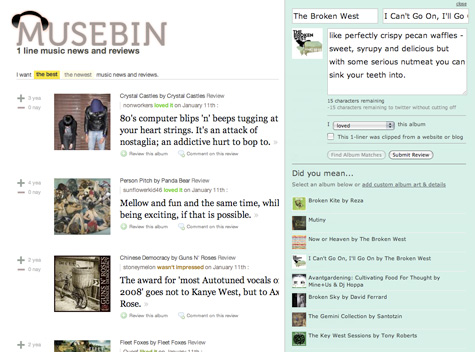
You have the ability to rate any review with a yea or nay and add your own comments. The combination of review plus rating provides a checks and balances system where the community can vote down overhyped albums and inflate albums with unjustified bad reviews. Album pages allow you to listen to the album through an embedded LaLa or 8tracks player. The sidebar also shows a customizable list of tons of music 2.0 services where you can either purchase, listen to or download the album.
Musebin is an engaging and entertaining experience but still lacks some features that will truly make it world class including the ability to follow other users and more robust discovery mechanisms (related artists, albums, etc). They also need simple tools that provide the ability to syndicate your own content on other web sites. It will be interesting to see how Musebin evolves as the industry is moving away from albums to singles, a trend well recognized and executed by a similar service, Blip.fm.
Twones Launches Music Activity Aggregator
 Twones, an Amsterdam-based startup, launched a beta of their new music activity aggregator/social network. The idea behind Twones is a solid one - there are so many music services out there and simply no way to get your friends to use the same one. This makes sharing music and seeing what your friends are listening to pretty difficult. In addition to tracking what you listen to on your media player (iTunes, Winamp, etc), Twones also allows you to track music you listen to on dozens of different music sites including Last.fm, iLike, YouTube, Finetune, MySpace, imeem, MOG, Seeqpod, Deezer, Hype Machine and many more. Your listening activity is then aggregated and presented on your Twones profile page. Friends can see what you are listening to and playback songs on their original source page or other services. When you find songs you like, you can bookmark them for later.
Twones, an Amsterdam-based startup, launched a beta of their new music activity aggregator/social network. The idea behind Twones is a solid one - there are so many music services out there and simply no way to get your friends to use the same one. This makes sharing music and seeing what your friends are listening to pretty difficult. In addition to tracking what you listen to on your media player (iTunes, Winamp, etc), Twones also allows you to track music you listen to on dozens of different music sites including Last.fm, iLike, YouTube, Finetune, MySpace, imeem, MOG, Seeqpod, Deezer, Hype Machine and many more. Your listening activity is then aggregated and presented on your Twones profile page. Friends can see what you are listening to and playback songs on their original source page or other services. When you find songs you like, you can bookmark them for later.
Lifestreaming services like Strands and Friendfeed require you to have accounts with specific services so they can access the RSS feeds of your listening activity. Twones, uses a Firefox plugin that basically tracks whatever you listen to on the web regardless of whether you have an account with a specific web service. This has the advantage of aggregating a much wider range of music activity. On the flipside, there is no way to globally block tracking on specific services aside from manually clicking the icon in the browser window to disable the tracker.
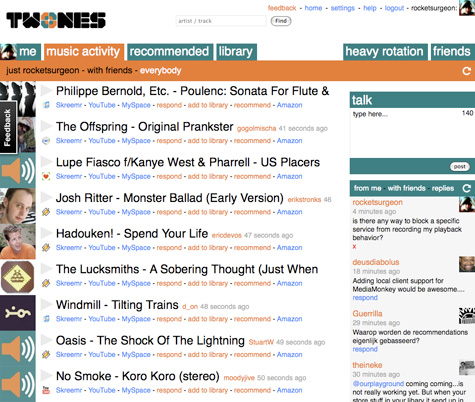
Like other social networks, you can find people to “follow”. When viewing the Music Activity tab, you can see your own activity, your friend’s activity and everyone’s activity. Its a good way to see what other people are listening to and discover new music.
Twones also lets you search for artists and songs. Search results and artist pages take a Foxytunes approach and are loaded with information including bios (Wikipedia), similar artists (Last.fm), concerts (Eventful), albums (Amazon), videos (YouTube), photos (Flickr), and recent chatter (Twitter).

There are some issues with the service. Your dashboard has a recommendations tab but that does not seem to be working yet or provide any explanation of what it is. The charts seems to be inoperable at this time as well. The UI attempts to be clean and concise but for some reason comes across as more clunky and cluttered. More attention to typography and better use of ajax for progressive disclosure of information would be a great help.
The Twones beta version is a promising start and clearly addresses a need with today’s multiple source model of digital music consumption.
JamsBio: Share Your Top 5 Desert Island List
 I’ve been playing around with a new music community site called JamsBio. The site allows you to create and share your own music reviews and top five lists like the ones sprinkled throughout, “High Fidelity”.
I’ve been playing around with a new music community site called JamsBio. The site allows you to create and share your own music reviews and top five lists like the ones sprinkled throughout, “High Fidelity”.
Creating your own list is simple and fun. After you name your list, you can search for songs to add. Select your desired track from the results and add an optional comment. When you are done you can publish the list to the JamsBio community and send it to friends. People can hear 30-second samples of the tracks and purchase them on Amazon or iTunes. Once the list is published, other people can add their own list based on the same subject you posted. JamsBio calculates each members individual list to create a master “people’s choice list”.
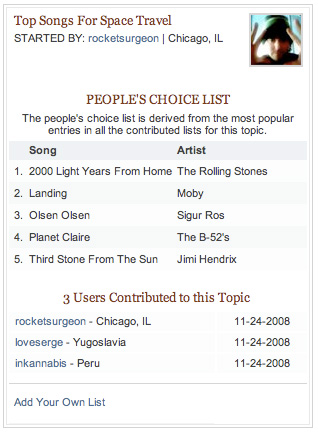
Unfortunately, as of now, there is no way to grab your list and embed it on your blog or website - an unforgivable omission in this day and age. There is also no ability to listen to full-length tracks via a subscription service (such as rhapsody) or export the tracks as a playlist file.
Creating your own reviews is also very simple. Search and find a song you wish to review and write your own review, memory, concert review or dedication. Unfortunately, there is no way to import my reviews into my blog or lifestream (though there is a embeddable widget)
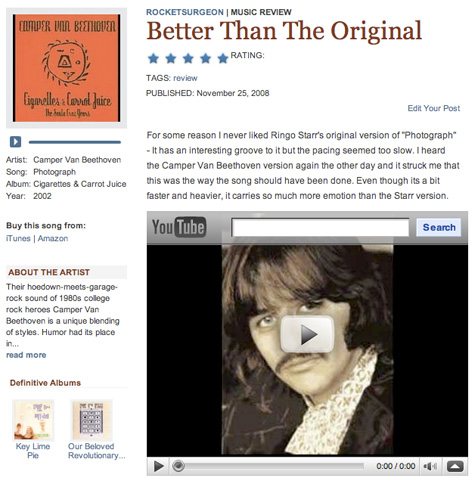
JamsBio’s (a funny sounding name when written as a possessive) listing, reviewing and even games components are all well designed and engaging experiences in and of themselves. Even the captcha in the registration process was pretty cool. However when taken as a whole, these elements don’t gel together yet as a cohesive site experience. Its difficult to find like-minded people, the search feature is a bit disjointed, artist and tag detail pages are difficult to find and many of the internal promotions clutter the otherwise streamlined UI. Many of these issues can be easily worked out over time and i look forward to the day that they are.
Amazon Windowshop: A Killer Browsing Experience
 Amazon recently released Windowshop Beta, an immersive user interface for exploring new releases and editors picks within books, music, movies and more. You use your arrow keys and spacebar to pan and zoom through the 3-D display of information. When you zoom in on an item - say an album, a song sample automatically plays. The same happens for movie trailers, audiobooks and even dead-tree editions. In fact, you don’t even need to use a mouse at all on the entire site except when you want to buy something (a “buy” keyboard command would be very nice). The next item automatically loads after the media sample for the current item ends. This is a nice touch because you can leave the window open, let it play while you do something else and come back when you hear something that sounds interesting.
Amazon recently released Windowshop Beta, an immersive user interface for exploring new releases and editors picks within books, music, movies and more. You use your arrow keys and spacebar to pan and zoom through the 3-D display of information. When you zoom in on an item - say an album, a song sample automatically plays. The same happens for movie trailers, audiobooks and even dead-tree editions. In fact, you don’t even need to use a mouse at all on the entire site except when you want to buy something (a “buy” keyboard command would be very nice). The next item automatically loads after the media sample for the current item ends. This is a nice touch because you can leave the window open, let it play while you do something else and come back when you hear something that sounds interesting.


Right now, the site is a pretty basic browsing experience, and a good one at that. If you want similar experience that actually allows you to search for specific items check out Cooliris.
Say It With a Song: Postcard.fm
 Why bother sending the standard ecard when you can say it with a song? Postcard.fm is an elegant, idiot-proof service from the same people who created the fantasy label site The Next Big Sound. The service lets you easily combine a photo, a song and a message for an awesome e-greeting. Photos can be directly uploaded from your computer or you can type in an image’s URL. You can also upload your own music file or search for a song using SeeqPod’s library of mp3 songs. Now i can finally mashup those wonderfully snarky greetings from someecards with equally cheeky music.
Why bother sending the standard ecard when you can say it with a song? Postcard.fm is an elegant, idiot-proof service from the same people who created the fantasy label site The Next Big Sound. The service lets you easily combine a photo, a song and a message for an awesome e-greeting. Photos can be directly uploaded from your computer or you can type in an image’s URL. You can also upload your own music file or search for a song using SeeqPod’s library of mp3 songs. Now i can finally mashup those wonderfully snarky greetings from someecards with equally cheeky music.
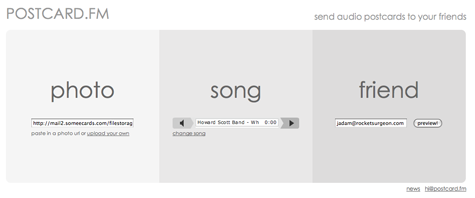
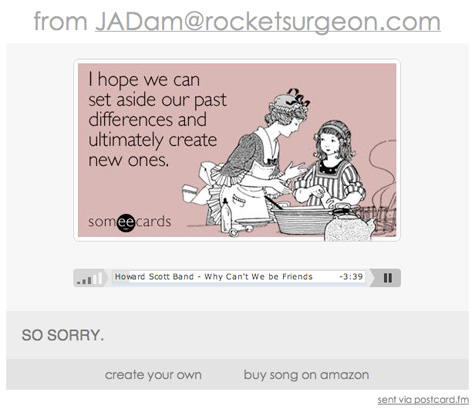
Music Recommender Mufin Goes Public
 Mufin provides song-based recommendations based on other songs. Unlike services such as Pandora which use human intervention to determine song characteristics, Mufin uses sound-based criteria such as such as rhythm, tempo, instrumentation and sound density to determine whether or not a song is similar to another song. After playing with the service for a while, i wish there was some human touch. Mufin’s recommendations aren’t terrible but they fall prey to the misunderstanding that I would like two songs simply because they sound alike. Measurable audio characteristics are important elements of a song’s construction, but without taking into account style, mood, and intent they are just loosely similar. Its like saying you would like two chairs because they are both black, leather, cushy, and swivel without taking into account the design, period and style.
Mufin provides song-based recommendations based on other songs. Unlike services such as Pandora which use human intervention to determine song characteristics, Mufin uses sound-based criteria such as such as rhythm, tempo, instrumentation and sound density to determine whether or not a song is similar to another song. After playing with the service for a while, i wish there was some human touch. Mufin’s recommendations aren’t terrible but they fall prey to the misunderstanding that I would like two songs simply because they sound alike. Measurable audio characteristics are important elements of a song’s construction, but without taking into account style, mood, and intent they are just loosely similar. Its like saying you would like two chairs because they are both black, leather, cushy, and swivel without taking into account the design, period and style.
You begin by typing in an artist or song name. Each result allows you to listen to a sample (when available) and view similar tracks directly inline. More often than not, many of the recommendations are the same song you are checking out or are not available to preview. If i cant hear a recommended song its useless to me and would prefer that you show me nothing at all. You can also add songs to a notepad (useful for remembering stuff you like) or a playlist. Why someone would want to create a playlist of 30 second samples is beyond me, but i suspect Mufin plans on providing some for of streaming playback sometime soon. Mufin also breaks the cardinal rule of multiple play button on a single page - when you click play on a different song, the original song does not stop. Try it out using “Row Row Row Your Boat”

There are some nice features though. Since they way you explore the site is to jump from song to song, Mufin keeps track of your clickstream history so you can easily go back and forth to previously viewed items. They also do some nice things with ajax in the UI to progressively disclose different types of information which makes for a pretty clean and uncluttered design.
Video Valve: Personalized Music TV
 Video Valve is a personalized music video channel from Viacom. As you rate videos and add artists to your channel, VV learns about your tastes and fine-tunes your video playlist accordingly. You can also further influence programming by adjusting popularity and freshness sliders.
Video Valve is a personalized music video channel from Viacom. As you rate videos and add artists to your channel, VV learns about your tastes and fine-tunes your video playlist accordingly. You can also further influence programming by adjusting popularity and freshness sliders.While the UI looks simple and straightforward its is very problematic. When you type in a an artist name, you will see live search results. Unfortunately, many items that display in the live search box are actually not represented in the catalog (it would be better to just restrict results to available content). There is also no difference between your play queue and search results - if you search for something new (or click an artist or director name), the results replace your play queue. Not only that, but it often inserts songs you have just listened to. It would be better to have the queue and results separate and provide the ability to add items from the results to the queue. This approach would also alleviate the site’s biggest problem - there is no apparent way to get back and access your personalized channel based on items you have rated.
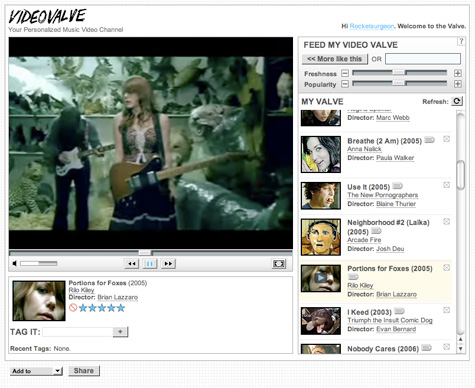
Ratings are also problematic - you can only rate videos but not artists. I may very much like an artist but not like a particular song and VV does not seem to have an understandable method for how this common occurrence is handled. There is also no way to see videos you have rated. Additionally, the site does not provide any data regarding what album the video is from or links to purchase songs.
VV does provide a nice selection of good quality video (that surpasses services that rely on poorly encoded or labeled YouTube for their content) and it’s fun to click around and check out different artists. However, the problems of the service are significant and need to be addressed before it can graduate to a truly compelling offering.
iToner: Custom Ringtones For Your iPhone
 Apple plans on launching their new ringtone service for the latest iTunes release sometime this week. The new service will only work with iTunes Store purchased tracks and will carry an additional cost above the standard track price. The latest upgrade also tried to disable the ability for users fto use their own tracks as ringtones. However, the newest version of iToner has adapted as quickly as the Borg to work with iTunes 7.4.1.
Apple plans on launching their new ringtone service for the latest iTunes release sometime this week. The new service will only work with iTunes Store purchased tracks and will carry an additional cost above the standard track price. The latest upgrade also tried to disable the ability for users fto use their own tracks as ringtones. However, the newest version of iToner has adapted as quickly as the Borg to work with iTunes 7.4.1.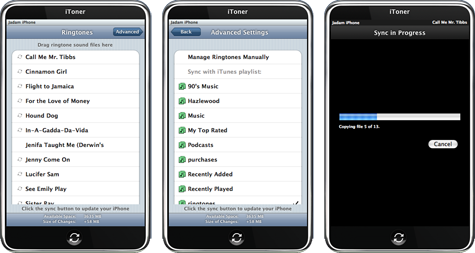
iToner is a simple utility that allows you to use your music collection as iPhone ringtones. Simply drag and drop music files on the iToner window and sync to your iPhone. You can also create a custom playlist within iTunes for your ringtones an use iToner to sync all content of the playlist. To assign a ringtone to a specific contact, just go to the edit contact screen on your iPhone, click “assign ringtone”, and select the ringtone you want.
Second Hand Songs: The Ultimate Cover Song Database
 If you are an obsessive playlist creator like me, you need to check out Second Hand Songs, a highly extensive covers and samples database. The additions to the database are the works of a group of fanatic cover song lovers, who devote their time on a voluntary basis. Users can submit songs though their forums. Unlike many related sites, they try to be as complete as possible (not just performer and song title, but also songwriters and original media) and order the data in a reusable and maintainable way.
If you are an obsessive playlist creator like me, you need to check out Second Hand Songs, a highly extensive covers and samples database. The additions to the database are the works of a group of fanatic cover song lovers, who devote their time on a voluntary basis. Users can submit songs though their forums. Unlike many related sites, they try to be as complete as possible (not just performer and song title, but also songwriters and original media) and order the data in a reusable and maintainable way.
To test out the site, I decided to create a playlist of all the samples used in the Beastie Boys masterpiece album “Paul’s Boutique”. Unfortunately I could not search for the album directly (search only scopes for song, artist and medium) but easily found a link on the Beastie’s main artist page. The album detail page alphabetically lists each song along with the recording date, sample sources, and artists who covered the song (though it would be nice to view the album in the original track order as well as alphabetically). Song detail pages list individual sources and allow users to report a missing source or error. It would be really great if they put links to listen to the songs in iTunes, Rhapsody or other services, which could also provide the service with a potential source of revenue.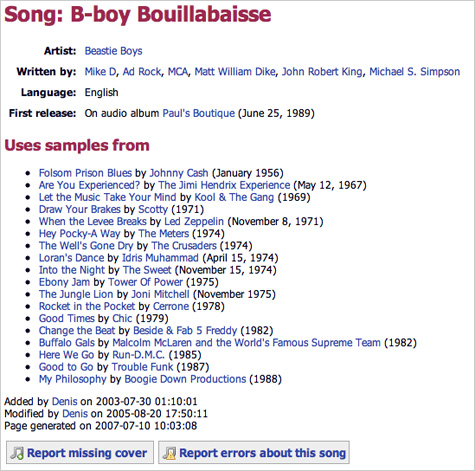
I then looked up each sample in Rhapsody and created the Paul’s Boutique Sample Vault. Because this album uses lots of rare materials, Rhapsody didn’t have all of the songs in their catalog but I did find about 85% of everything listed.
Listen to Paul’s Botique Sample Vault
Some ideas for playlists you can create by leveraging the database include:
• Collection of samples from an album
• Collection of covers from an artist
• Collection of covers of a song
• Collection of originals for popular cover songs
• Cover chain (artist A covered artist B covered artist C, etc.)
SHS also has an interesting statistics area where you can find information like most covered/sampled author and performer, most covered/sampled song, and longest cover chain.
Fairtilizer: Community-Driven Charting
 I finally got a chance to check out
I finally got a chance to check out
Members have the ability to post content to a buffer area where Fairtilizer determines if the track does not infringe on copyright and passes their editorial standards. Junior and Senior members, which I assume are verified artists and labels, have the ability to circumvent the buffer zone. While the distinctions between membership tiers is undocumented and taxonomically confusing, this approach is a good way to ensure legality and content quality.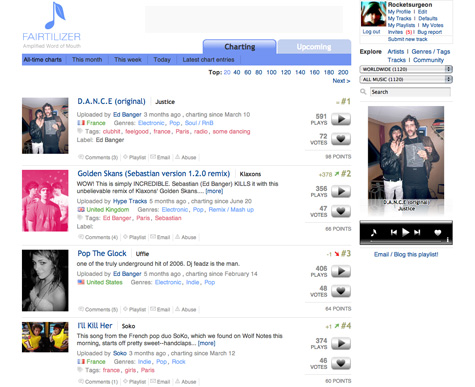
The home page presents a list of all-time chart toppers that include descriptions, country of origin, genres, tags, rank, number of plays, and number of votes. You can also access charts for the month, week and day. You can also filter tracks by tag, country of origin, and genre - so for instance I can see all girl-based pop tracks from France (btw there are 2 to date). The filter controls could use a bit of redesigning as they seem to be scattered throughout the page and the # of tracks displayed in the pull down menus for country and genre don’t update as you add filters. Tracks are played in a flash-based player on the right of the screen. Unfortunately when you navigate to another page, the playback stops. You can pop-up the tuner in a different window but it doesn’t work when you click play on a different track. The service allows you to comment on individual tracks and add them to a playlist. Playlists are easily managed and can be embedded in webpages and blogs.
Tracks are played in a flash-based player on the right of the screen. Unfortunately when you navigate to another page, the playback stops. You can pop-up the tuner in a different window but it doesn’t work when you click play on a different track. The service allows you to comment on individual tracks and add them to a playlist. Playlists are easily managed and can be embedded in webpages and blogs.
Despite the many UI issues, the community-driven charting model does indeed result in some really great music discovery. In the short time I have used the service, i have found a variety of songs and bands I really like and would likely not have found. Fairtilizer is only available by invite at this time but you can request one at their site.
Sonific: More Choice, but Major Issues Remain
 Sonific allows users to select a song from their catalog and add it to any website, blog or social network profile. I have been aware for them for some time but avoided using the service because their catalog was so small and I had a very difficult time finding anything I would want to hear. Thankfully, Sonific has added another 100,000 tracks with an emphasis on Jazz and Blues. They have also announced a new beta service that allows artists and labels to upload their own content for use within the Sonific network.
Sonific allows users to select a song from their catalog and add it to any website, blog or social network profile. I have been aware for them for some time but avoided using the service because their catalog was so small and I had a very difficult time finding anything I would want to hear. Thankfully, Sonific has added another 100,000 tracks with an emphasis on Jazz and Blues. They have also announced a new beta service that allows artists and labels to upload their own content for use within the Sonific network.
At least they have some music I like now. However the service still sufferers from a few major problems. Now that the catalog is growing, they need to seriously work on their search and browse functionality. Genres are represented using a tag cloud which doesn’t make much sense as users can’t tag songs. It’s also a waste of space since there are only about 12 genres to choose from. When selecting a genre from their tag cloud, you get a list of subgenres and featured artists. However, many times a subgenre will return no results. Suggestion: Hide subgenres if you don’t have any content in them. They could also use a genre-specific page that contains charts of top songs, top artists, etc. 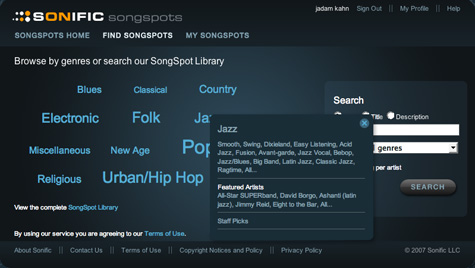
There’s no way to currently just see a list of artists in a genre without scrolling through a very large set of song-based search results. Suggestion: provide a way to quickly browse artists outside the context of a song. iTunes’ 4-pane browse feature does this well and LaLa has extended it to their new service. And last but not least, the fact that I need to click the “Find Songspots” tab every time i want to find something is needlessly annoying. Suggestion: provide a persistent search box on every page.
Setting up a Songspot for your site is pretty straightforward and they support over 42 platforms. Just select the “Use” button on any item you want and configure the widget for your site. My only suggestion here would be for a live preview of the player that dynamically updates as you change your settings. Sonific keeps a record of your songspots and you can always go back and edit ones you have created. 
My major issue with Sonific is that other services out there (legal issues aside) like imeem, ProjectPlaylist, Finetune and Dizzler allow you to create and share entire playlists of music where Sonfic restricts you to a single song. This may be cool for a “Song of the Day” feature or featuring a specific podcast. However, in the end I don’t know if this model can compete with the ability to share multiple songs via a single widget.
Bands In Town: Slick Concert Tracking
 Bandsintown is a new Music 2.0 concert tracking service that just launched today. Like most services in this category, Bandsintown allows you to track your favorite artists and see when they are coming to your town. The service will send weekly email notifications of upcoming shows from your tracked artists as well as recommended shows.
Bandsintown is a new Music 2.0 concert tracking service that just launched today. Like most services in this category, Bandsintown allows you to track your favorite artists and see when they are coming to your town. The service will send weekly email notifications of upcoming shows from your tracked artists as well as recommended shows.After you register for your free account, you can manually add artists you wish to track or import your top artists directly from a Last.fm account. The “Shows” page displays all upcoming shows in your area though the use of a tag cloud. The service utilizes a very slick AJAX interface that allows you to dynamically change the date range, distance from city, max ticket prices and label type to update the tag cloud. Artists that match your favorites are shown in larger type so you can find them easier. Simply rollover an artist name to see a show summary and click it to view the show detail page.

BIT also provides a calendar view that quickly lets you see shows from favorite artists and shows you want to attend.

Show detail pages contain all the relevant information such as time, place, ticket info, a Google Map and show poster. Users have the ability to add events and edit venue and artist information. You can view other user pages and see their upcoming shows and favorites, but at this time there is no way to add them as a friend or leave them messages.
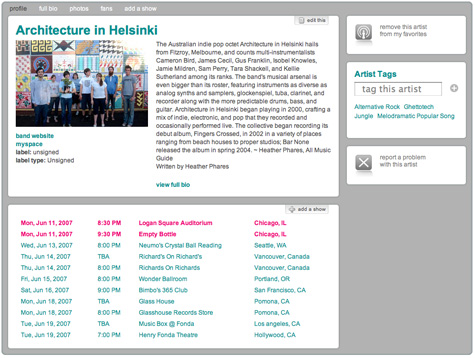
Of all the concert tracking tools I’ve reviewed, BIT has one of the best UI’s. Aside from some light community features, the only issue I really have with the service is adding artists. While a Last.fm import helps build your favorites, it appears they only use your top 50 artists. To add more artists, you need to go directly to their artist page or enter them manually. They need to explore more ways of quickly adding artists to your favorites, either by integrating that functionality into rollovers or letting you expand the range of artists pulled from Last.fm.
View My Bandsintown Page
see also: Concert 2.0 - 12 Personalized Concert Listing Tools
Seeqpod: Playable Music Search
 Seeqpod is a new music search service that allows you to search for mp3 and videos scattered around the web. Instead of just providing links to mp3s, Seeqpod provides a set of playable search results that can be added to a playlist.
Seeqpod is a new music search service that allows you to search for mp3 and videos scattered around the web. Instead of just providing links to mp3s, Seeqpod provides a set of playable search results that can be added to a playlist.The site utilized a minimal flash-based UI. Search features are on the left and playlist features on the right. To begin, you just enter a search term and Seeqpod delivers a set of matching results. To hear a song just click the play button or click the video button to see matching videos. Each song also has additional links to blogs (Google), MySpace, Wikipedia, lyrics (Astraweb), tour dates (Pollstar), ringtones (Jamster), news (Google) and Purchase (Amazon).

Seeqpod also provides some tools for discovering music. If you click the discover tab in the results area, you will see a set of songs from related artists. It’s not exactly clear how these are being calculated and on many occasions, the results didn’t seem that related at all. if you click the PodCrawler tab, you will see a continuously scrolling list of mp3s that Seeqpod is currently indexing. Its kinda fun to watch as it works and if you watch it long enough you just may find something interesting.
To add a song to a playlist just click the green arrow that appears when hovering over a song. You need to complete a simple and free registration process to save your playlists. To arrange tracks in your playlist, just drag and drop songs in your desired order. Seeqpod provides simple tools to email them to friends or embed them on your blog or website.

While Seeqpod does show the source of mp3 files, they do not provide an option to download them directly. They also claim to follow the DMCA. Check out a sample playlist below:
We7 Review: Free Ad-Supported Downloads
 We7, a new service from Peter Gabriel, officially launched a beta site of their ad-supported, DRM-free download service. The business model is pretty straightforward - users can download free music that contains short, targeted ads at the start of the song and the artists receive income from the ad revenue. We7 promises that the spots will contain relevant and entertaining information that users will not find distasteful. They eventually want downloaders to choose the type and style of ads they hear to make the experience even better. They are also planning for the ads to disappear from songs after a certain time period which at this point is set at 4 weeks.
We7, a new service from Peter Gabriel, officially launched a beta site of their ad-supported, DRM-free download service. The business model is pretty straightforward - users can download free music that contains short, targeted ads at the start of the song and the artists receive income from the ad revenue. We7 promises that the spots will contain relevant and entertaining information that users will not find distasteful. They eventually want downloaders to choose the type and style of ads they hear to make the experience even better. They are also planning for the ads to disappear from songs after a certain time period which at this point is set at 4 weeks.
Once you register for your free account you will have the ability to browse music, create a playlist and download music. The catalog at this stage is pretty pathetic - there are only about 100 total songs from 25 artists available across all genres. Plus you would think that there would be at least songs by Peter Gabriel, but alas, no. You can browse music by a set of limited genre but hopefully the genre selection will get better as more artists are added. You can click play next to any track to hear a 30-second sample of the song. Unfortunately, you need to navigate to another page for playback which becomes a real nuisance when you want to hear lots of songs. They should seriously consider providing in-page playback. You also have the option of purchasing the song or adding it to your playlist.
You can’t download individual songs until you have added them to your playlist which is limited to 60 items. However, We7 provides a variety of way of getting music to your computer. You can either manually download items in your playlist or download them all as a single zip file. You can also subscribe to you playlist as a iTunes podcast or subscribe to an RSS feed for the playlist to hear it with another service. They also provide a widget so you can share your playlist on your MySpace, Blog or website.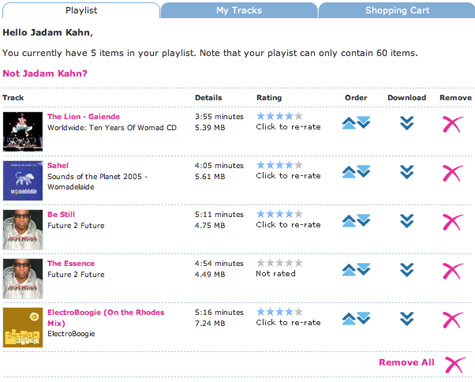
Users have the ability to both rate and comment on tracks, albums, and artists. Aside from that, there are no traditional community features such as member profiles. They do provide an interesting feature is called Tastemakers. Basically We7 allows independent artists to upload music to their service. However, instead of just publishing everything, they allow the user community to review music first to help them decide what is good enough to make public. Artists need to rate at least five songs before they have the ability to upload their own music. It’s an interesting concept that helps We7 establish community feedback and control the quality of content they offer for download.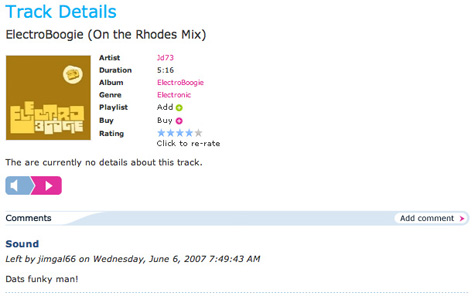
The current downloads just have We7 promo spots so its difficult to tell how annoying they will be once real ads are implemented. However, if they live up to their promise and seriously address the catalog issue, We7 may prove to be a pretty promising model.
NuTsie Review: iTunes on Your Phone
 I have an iPod and a cellphone, though most of the time just carry the latter. nuTsie (beta) is a new application that allows you to access your iTunes playlists through your cell phone. After you register for your free account, nuTsie sends a text message to your cell phone with a link to download their mobile application. On the web site, you are taken to a page to upload your ITunes library XML file. nuTsie then tries to match songs in your library with songs in their catalog on their server. This process may take a while depending on the size of your library but they will send you a text message to your cell phone when the process is complete.
I have an iPod and a cellphone, though most of the time just carry the latter. nuTsie (beta) is a new application that allows you to access your iTunes playlists through your cell phone. After you register for your free account, nuTsie sends a text message to your cell phone with a link to download their mobile application. On the web site, you are taken to a page to upload your ITunes library XML file. nuTsie then tries to match songs in your library with songs in their catalog on their server. This process may take a while depending on the size of your library but they will send you a text message to your cell phone when the process is complete.The nuTsie web site provides you with a dashboard/profile page that contains links to all of your playlists. nuTsie only provides songs in your library that match items in their catalog and unfortunately, the catalog seems to be pretty slim - only a tiny fraction of my songs actually matched.

Don’t think of your playlists in the traditional way - think of them as stations with pre-determined content. The service seems to follow DMCA rules for playback - such as random order, no knowledge of the next track and no skipping back tracks. You have the ability to hear your playlists directly in the browser if you don’t want to use your cellphone.
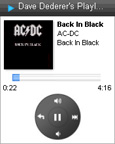 I personally have a Motorola Krazr, which is not currently supported by nuTsie so I did not get a chance to test out the service on a mobile device. However, their site provides a pretty good overview of the UI. After you launch the application on your phone you will see a collection of all your playlists. When listening to a playlist, you will see the album art, metadata, track progress, and graphic that explains how to control playback. While nuTsie is free, it will eat up your data minutes, so be careful unless you have an unlimited data plan.
I personally have a Motorola Krazr, which is not currently supported by nuTsie so I did not get a chance to test out the service on a mobile device. However, their site provides a pretty good overview of the UI. After you launch the application on your phone you will see a collection of all your playlists. When listening to a playlist, you will see the album art, metadata, track progress, and graphic that explains how to control playback. While nuTsie is free, it will eat up your data minutes, so be careful unless you have an unlimited data plan.At this time there is no way to make your profile or specific playlists private. You can also listen to other users’ playlists, though nuTsie lacks the ability to browse or search members or playlists in any easy way. Its also uncertain whether you can access member playlists via your phone. The UI is very plain, crowded and can use some reorganization to make primary actions more prominent.
nuTsie is only in beta, but if they address the issues around their catalog size, community development and user experience, they may have a very compelling service. nuTsie’s comes at the same time Pandora announced products to deliver streaming radio to certain cell phones. Couple that with the introduction of the iPhone later this month the mobile music market is looking at a promising 2007.
LaLa: The Danger of Doing Too Much
 LaLa, the CD trading service just launched a new free service that allows members to a play songs on demand, upload their music collection for everywhere access, and transfer music directly to iPods. Users can currently access roughly 200,000 tracks of WMG content for play-on-demand (and hopefully more from other major and independent labels soon). After playing around with the new service for a while, I have some serious misgivings about their implementation and new model.
LaLa, the CD trading service just launched a new free service that allows members to a play songs on demand, upload their music collection for everywhere access, and transfer music directly to iPods. Users can currently access roughly 200,000 tracks of WMG content for play-on-demand (and hopefully more from other major and independent labels soon). After playing around with the new service for a while, I have some serious misgivings about their implementation and new model.
Installation & Registration
The LaLa player is a small application available for both Mac and PC. The program allows you to “upload” your music collection to LaLa and play your own music, your friends music and tracks featured on LaLa directly within the browser. After you install the player you need to sign up for a free account. Once you are registered you are taken to your “My Music” page. This is where you can upload and access your music library, access and create playlists, and sync to your ipod. It also takes a while to find out where you can upload your profile picture (just look at the People section under the Discover tab and you will see I’m not the only one).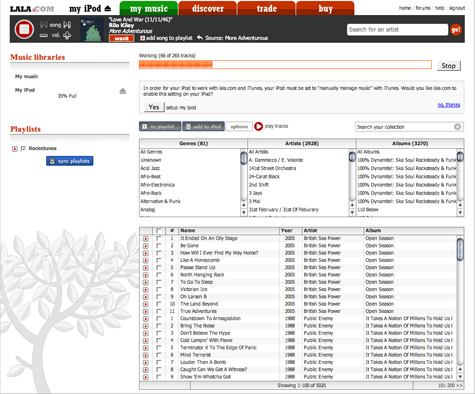
Uploading Music
The process is a bit confusing and LaLa needs to do a much better job of explaining how their service works. First off, does LaLa actually physically upload my music to a server, does it simply scan my library and match songs already on their servers, or is it a combination of both? I have over 21,000 songs in my library and uploading 90Gb of music will not only cost me time but money in bandwidth costs. If I navigate away from the page will my uploading process stop? It took me a while to notice that the LaLa application is not only running in the browser but also in the OSX menu bar. The progress bar also seems to give vague and conflicting information, often disappears on page refreshes, and seriously hampers the performance of the service. 
Finding and Playing Music
LaLa provides standard search and browse features for finding music. Similar to Yottamusic, LaLa has a smart search feature that shows matching artists while you type. Why every music service hasn’t figured this one out is beyond me. Browsing by genre is a little less helpful. The main genre selection is sparse (no alternative, world and other popular genres) and no way to dive deeper into subgenres and styles. Main genres pages are poorly marked, there are no genre specific new releases, top artist charts or top songs charts. Individual artist pages are better and contain bios from Wikipedia, discography, top songs, videos from Google, related artists, and fans. They also provide a related artist radio feature. Album pages contain user-created reviews, associated tags, related playlists and fans.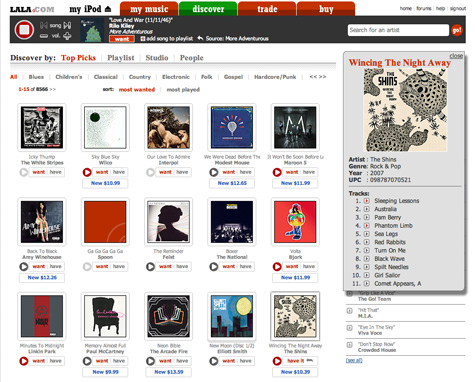
Individual songs and albums are marked with either a grey or red play button. Grey buttons indicate you can hear 30-second samples and red buttons indicate you can hear the full-length track. For some reason, I could not get any samples to play but had no problems with full-length tracks.  Syncing
Syncing
Once I connected my iPod, I went to an album page of something that was available for on-demand, checked off a bunch of tracks and clicked the “Add to iPod” button. Thats where I got the “You can only sync tracks you own” messaging. Ok then why the hell are giving me the option to sync? LaLa has done a terrible job of explaining the sync feature - I was under the impression that I could add music to my iPod even if i didn’t own it but that just doesn’t seem to be the case. As far as being able to sync my iPod when I don’t have access to iTunes - well OK but personally I really have no use for that.
The Danger of Doing to Much
LaLa started as a CD trading service and the entire experience was built around that primary model - and it worked well. The ability to upload my digital collection and play catalog songs on demand drastically changes the mental model of the service. For instance, under each album there are “want” and “have” buttons. Well what exactly does “have” mean now that i can upload my digital collection? If i bought the album on iTunes, do i “have” it? When I view albums in Rhapsody, I know that (almost) every track is available for playback. This is not the case with LaLa. Albums can either be available for play-on-demand, samples only or no playback at all. Sometimes the CD versions are available for sale and other times they are not. Eventually LaLa will have digital purchases as well. Hopefully as more label deals are signed it will get better but for now this will only lead to user frustration. My experience at MusicNow has taught me that users have a difficult enough time understanding the difference between a subscription service and a store. If the reactions on LaLa’s forum are any indication, users resent the move to be all things to all people.

Tangerine Review: Tempo-Based Playlists
 Tangerine is a standalone Mac utility that generates playlists based on beats per minute and beat intensity. The application will scan and analyze your music library, and assign BPM and BI values to each song. This process can take awhile depending on your computer speed and library size (they claim roughly 3000K songs in 20 minutes on a core duo Mac). You don’t need to worry about analyzing new songs, Tangerine will automatically analyze them when it is launched. If a song was incorrectly analyzed, you can use the BPM calculator to manually calculate BPMs. With a paid copy of the program, you can even export the BPM information directly to iTunes.
Tangerine is a standalone Mac utility that generates playlists based on beats per minute and beat intensity. The application will scan and analyze your music library, and assign BPM and BI values to each song. This process can take awhile depending on your computer speed and library size (they claim roughly 3000K songs in 20 minutes on a core duo Mac). You don’t need to worry about analyzing new songs, Tangerine will automatically analyze them when it is launched. If a song was incorrectly analyzed, you can use the BPM calculator to manually calculate BPMs. With a paid copy of the program, you can even export the BPM information directly to iTunes.
The Tangerine UI is very similar to iTunes and displays not only your music library, but your iTunes playlists as well. Once the beat information for your library is complete, you can begin creating playlists. Its very easy to create a new playlist. Similar to iTunes’ smart playlists, Tangerine allows you to set rules for your playlist including total time, restricting artists, albums, genres, duration, ratings, playcount and more. You can then set additional BPM and beat intensity ranges and the playlist generation pattern. For example, you can create a mix that steadily increases in tempo and intensity and then gradually quiets down. There is even a metronome built into the slider that lets you hear example tempos as you adjust the BPM range. As you tweak your parameters, Tangerine lets you know how many songs match your criteria.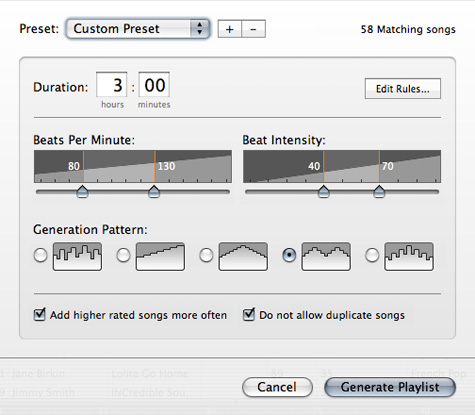
It may take a few minutes for your the playlist to generate and unfortunately, Tangerine does not provide any kind of status meter to indicate how long the wait will be. Playlists are presented in the bottom half of the window as a collection of differently sized album covers. The width of the album cover indicates the song length and the height corresponds to its BPM. You have the ability to reorder and remove items in the playlist. Clicking save will then send your new playlist directly to iTunes. You can also listen to playlists directly in Tangerine but the utility doesn’t have smooth fades between songs.
By itself, you can use Tangerine to create some really great tempo-based playlists. However, the real power comes when using it in conjunction with some other iTunes playlist utilities such as The Filter (good creating playlists of related songs), Moody (good for creating playlists based on moods), and NextTune (good for creating playlists based on moods, instruments and other traits). Tangerine is currenlty offered as a 15 day free trial and costs $24.95 for a full copy.
Blogmusik Review: Streaming MP3 Service
 Another entry into the ad-supported streaming music game is Paris based Blogmusik, which launched a new version of their site a little over a month ago. Blogmusik allows you to search for music and play songs and albums on demand. The selection is actually very good - that’s because all the music in the service is uploaded by their community. The legality of the service is a little murky and Blogmusik doesn’t fully explain how it works, though when uploading songs they claim:
Another entry into the ad-supported streaming music game is Paris based Blogmusik, which launched a new version of their site a little over a month ago. Blogmusik allows you to search for music and play songs and albums on demand. The selection is actually very good - that’s because all the music in the service is uploaded by their community. The legality of the service is a little murky and Blogmusik doesn’t fully explain how it works, though when uploading songs they claim:
“All tracks available to the user of Blogmusik have been thoroughly analyzed by our song recognition engine. Each title you’ll upload will be analyzed, if a track matches an official release then it will be available to the community. This process takes a bit of time and is mandatory to pay the artists. If a track is not recognized, it’ll only be available for you through the ‘My MP3’ section. You’ll be able to share these songs through the ‘Blog & Share’ section.”
Aside from the legal issues, Blogmusik is a very cool service. The Web 2.0 style, Flash-based UI is clean and elegant and allows for some very cool interactions such as drag and drop. Just type your keyword into the search box and browse the matching results and click play to hear the song. There is also the ability to purchase the songs on iTunes and Amazon. You can share any song on your blog using an embeddable player or email a song to a friend. On many occasions I found a fairly long wait while the song loads which is the biggest problem area for the service.

You can also view details for any album and see all available tracks for that album. Unfortunately, there are no artist bios or related artist information available.
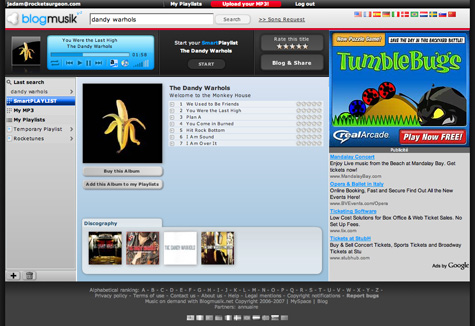
The primary concept of Blogmusik revolves around playlists. Creating a playlist is very easy - just click the “+” icon and an name your playlist. It then appears in the right column of the site. As you find songs in the service, you can just drag and drop them directly onto the playlist name to add them to your playlist. At this point there is no way to share your playlists, but the Blogmusik blog announced that feature is coming soon.

When you listen to an artist, you can click the “Smart Playlist” option to generate a DMCA compliant playlist based on the chosen artist. The smart playlist UI is very slick and clean. If you like a song, you can drag it directly to any of your custom playlists. If you don’t like a song you can click the broken heart icon to never hear the song again. Due to DMCA restrictions, you can’t save a playlist, cant go back and have a 3 hour listening limit. There doesn’t seem to be any limitations on skipping songs though. Even though you can’t save a smart playlist, it would be nice to be able to bookmark it for future access. They should also consider changing the name of this feature since Smart Playlist already has a fairly accepted meaning in iTunes and the feature behaves more like an artist station.
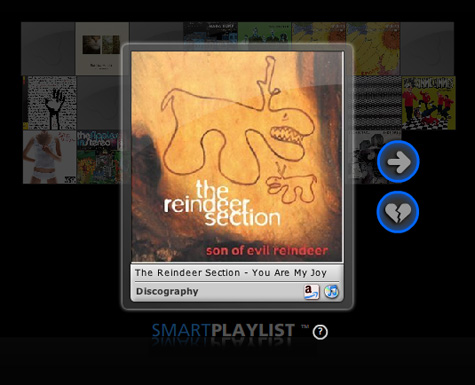
Aside from some the performance issues, Blogmusik is a very interesting addition to the Music 2.0 space and I strongly recommend checking it out. As far as the legality, I wish they would be more up front about their model so that users know what if they are getting involved an investing time with a legitimate service.
NextTune Mood-Based Playlists
 NextTune recently released a new version of their Mood Maker playlist creation software for both Mac and PC. Essentially, Mood Maker software is a standalone media player and playlist composer. Unlike some other tools like Moody, Mood Maker supports DRM versions of AAC and WMA.
NextTune recently released a new version of their Mood Maker playlist creation software for both Mac and PC. Essentially, Mood Maker software is a standalone media player and playlist composer. Unlike some other tools like Moody, Mood Maker supports DRM versions of AAC and WMA.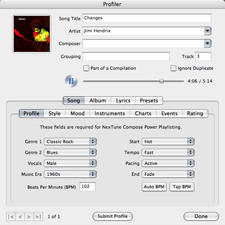 After you import your music library, you can get profiles from NexTune’s online database for all the songs in your library. The song profiles contain a wealth of information including genres, styles, tempo, bpm, start/begining characteristics, moods, and many other song facets. Unfortunately if you have a very large library, getting profiles can be an incredibly slow process. Luckily you can have Mood Maker retrieve song profiles in the background but expect to run it for a few nights while you sleep. If there is no profile in the database, you can enter your own information and submit it to their database. NexTune lets you know if they are looking for information for specific tracks. if you are the first person to upload the information they credit your account with .10 NextDollars which you can use to purchase CDs from their online store.
After you import your music library, you can get profiles from NexTune’s online database for all the songs in your library. The song profiles contain a wealth of information including genres, styles, tempo, bpm, start/begining characteristics, moods, and many other song facets. Unfortunately if you have a very large library, getting profiles can be an incredibly slow process. Luckily you can have Mood Maker retrieve song profiles in the background but expect to run it for a few nights while you sleep. If there is no profile in the database, you can enter your own information and submit it to their database. NexTune lets you know if they are looking for information for specific tracks. if you are the first person to upload the information they credit your account with .10 NextDollars which you can use to purchase CDs from their online store.
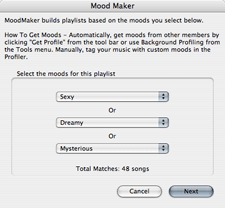 Creating a Mood Maker playlist is a multistep process but very straightforward. Start by selecting up to three moods. As you select the moods the number of available tracks are shown on the display. You can then further configure the playlist by selecting genres and eras to include. Mood Maker also allows you to arrange the playlist by either grouping or randomizing the artists and genres. Additionally, you can create listening cycles which gradually increase and decrease the playlist tempo within a specific time cycle.
Creating a Mood Maker playlist is a multistep process but very straightforward. Start by selecting up to three moods. As you select the moods the number of available tracks are shown on the display. You can then further configure the playlist by selecting genres and eras to include. Mood Maker also allows you to arrange the playlist by either grouping or randomizing the artists and genres. Additionally, you can create listening cycles which gradually increase and decrease the playlist tempo within a specific time cycle.
The resulting playlists are very good but you need to have an appropriate number of songs profiled if you don’t wish to have lots of repeat artists. You can export your playlists directly to iTunes and Windows Media Player as well as your iPod. You can also burn CDs (no DRM files though).
The problem I have with standalone software like this is that it essentially acts as a second media player instead of complementing the one I already use. I have almost 22,000 songs in my library and managing them in iTunes alone is hard enough. The amount of work required to profile all those songs in yet another application is a lot to ask (only about 20% of my music seems to be in their database). Tools like Moody don’t have the same level of detail or sophistication, but the data it generates goes directly into my iTunes comment tags. Unfortunately, iTunes does not have support for all the information stored in NextTune so there really is no good way to get around this issue.





 Del.icio.us
Del.icio.us Last.fm
Last.fm Strands
Strands Virb
Virb YouTube
YouTube
